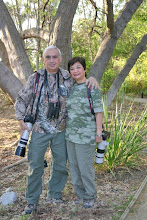It was a long, tiring trip from Los Angeles to our final destination: the Savegre Nature Resort and Spa in the town of San Gerardo de Dota arriving there at around 6 pm. Having left California a little past midnight, we were understandably plastered and fast asleep as soon as we checked in into our room.
Bright and early the following morning, we were awakened by the song of the aptly named Melodious Blackbird. Interestingly, this species do not show up in any of the bird lists of this area. According to Wikipedia, prior to 1989 there was only one record in Costa Rica. Yet now, this became our regular wake up call every morning. They are actually quite common in the premises.
Another "trash" bird is the Rufous-collared Sparrow. They are everywhere just like the Eurasian Tree Sparrow in the Philippines and the House Sparrow in the U.S. This one is a bit more colorful though.
Around the restaurant and the office were feeders - both for the hummingbirds and for the fruit-eaters. We saw 6 different kinds of hummers, 5 of which were lifers. The non-hummingbird feeders attract a variety of birds - most common being the Tanagers: Flame-colored, Silver-throated and Blue-grey. Occasionally, a migrant, the Tennessee Warbler would also drop by.
 |
| Tennessee Warbler |
Our hotel offers various birding tours which would take visitors to the different areas around San Gerardo de Dota. One of these tours was for Quetzal sightings. However, while having breakfast that morning, a couple dining next to us gave us a tip. "Take the road going out of the hotel and look for a sign nailed to a tree trunk that says 'no lance la basura' (don't throw garbage). Look across the stream from that place and you will see the nest (a hole in the tree trunk). The parent Quetzals are always there."
As soon as we finished our morning repast we hied over to the directions given us. It didn't take us long to find the sign. And there, as our new friends assured us, was the female Quetzal. While taking pictures of the Mom, I noticed that there were birders on that side of the stream - which, of course, was much nearer to the bird! So, there we went also. Indeed the view was definitely closer. With only the female there, most of the birders left the area leaving just me and Cynthia and another bird photographer.
We were scouring the boulders on the stream hoping to find an American Dipper (which had been seen sporadically here) when the male Quetzal appeared near the tree where their nest was. However its perch of choice was slightly covered by some branches and leaves. Despite that we still got busy taking its picture. Then, as if summoned by a higher power, the male flew to an open branch where it can now be better viewed and much closer than before.
After taking hundreds of shots (unusual for me to do) it was us, unbelievably, who gave up. Imagine that we got this incredible opportunity and didn't even have to shell out the $75 (per person) tour fee. Exhilarated, we returned to the area near the restaurant to take a breather from all that excitement at seeing the star bird of Costa Rica that close and that open! I jokingly told my wife that we better quit now while were ahead with our target birds. However, nature has a funny way of dealing with us people. As soon as I said that joke, the Long-tailed Silky Flycatcher, another gorgeous Costa Rican bird, flew in and perched at about 5 meters away from us as if to say, hey, there are other beauties here than those quetzals! They were so close that I at first I could only manage head shots. Thankfully I had a zoom lens and was able to change my setting from 600mm to 350mm just so I can get the full body in the frame.
All these and it's not even 10 am!






















































